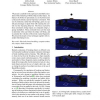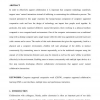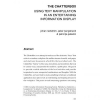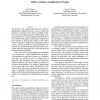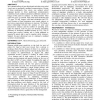GRAPHICSINTERFACE
2000
15 years 1 months ago
2000
We present a method for the rapid and controllable simulation of the shattering of brittle objects under impact. An object to be broken is represented as a set of point masses con...
126
click to vote
GRAPHICSINTERFACE
2000
15 years 1 months ago
2000
Skinning geometry effectively continues to be one of the more challenging and time consuming aspects of character setup. While anatomic and physically based approaches to skinning...
GRAPHICSINTERFACE
2000
15 years 1 months ago
2000
113
click to vote
GRAPHICSINTERFACE
2000
15 years 1 months ago
2000
We introduce an algorithm for high-quality, interactive light field rendering from only a small number of input images with dense depth information. The algorithm bridges the gap ...
GRAPHICSINTERFACE
2000
15 years 1 months ago
2000
126
click to vote
GRAPHICSINTERFACE
2000
15 years 1 months ago
2000
We introduce a new metaphor for learning spatial relations--the 3D puzzle. With this metaphor users learn spatial relations by assembling a geometric model themselves. For this pu...
143
click to vote
GRAPHICSINTERFACE
2000
15 years 1 months ago
2000
This paper describes a texture generation technique that combines orientation and luminance to support the simultaneous display of multiple overlapping scalar fields. Our orientat...
108
Voted
GRAPHICSINTERFACE
2000
15 years 1 months ago
2000
This paper describes a technique for using magnetic motion capture data to determine the joint parameters of an articulated hierarchy. This technique makes it possible to determin...
86
Voted
GRAPHICSINTERFACE
2000
15 years 1 months ago
2000
We describe a 3D graphical interaction tool called an amplification widget that allows a user to control the position or orientation of an object at multiple scales. Fine and coar...
111
Voted
GRAPHICSINTERFACE
2000
15 years 1 months ago
2000
We evaluated effects of gaze directional and other non-verbal visual cues on multiparty mediated communication. Groups of three participants (two actors, one subject) solved langu...
